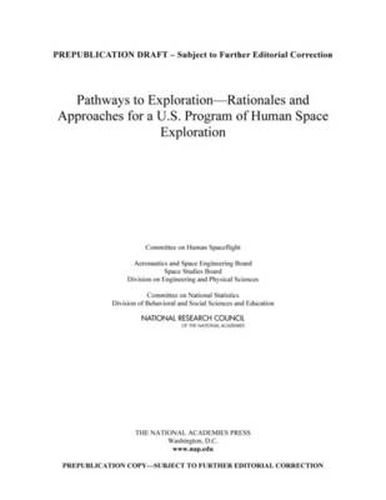Readings Newsletter
Become a Readings Member to make your shopping experience even easier.
Sign in or sign up for free!
You’re not far away from qualifying for FREE standard shipping within Australia
You’ve qualified for FREE standard shipping within Australia
The cart is loading…






The United States has publicly funded its human spaceflight program on a continuous basis for more than a half-century, through three wars and a half-dozen recessions, from the early Mercury and Gemini suborbital and Earth orbital missions, to the lunar landings, and thence to the first reusable winged crewed spaceplane that the United States operated for three decades. Today the United States is the major partner in a massive orbital facility - the International Space Station - that is becoming the focal point for the first tentative steps in commercial cargo and crewed orbital space flights. And yet, the long-term future of human spaceflight beyond this project is unclear. Pronouncements by multiple presidents of bold new ventures by Americans to the Moon, to Mars, and to an asteroid in its native orbit, have not been matched by the same commitment that accompanied President Kennedy\‘s now fabled 1961 speech-namely, the substantial increase in NASA funding needed to make it happen. Are we still committed to advancing human spaceflight? What should a long-term goal be, and what does the United States need to do to achieve it? Pathways to Exploration explores the case for advancing this endeavor, drawing on the history of rationales for human spaceflight, examining the attitudes of stakeholders and the public, and carefully assessing the technical and fiscal realities. This report recommends maintaining the long-term focus on Mars as the horizon goal for human space exploration. With this goal in mind, the report considers funding levels necessary to maintain a robust tempo of execution, current research and exploration projects and the time/resources needed to continue them, and international cooperation that could contribute to the achievement of spaceflight to Mars. According to Pathways to Exploration, a successful U.S. program would require sustained national commitment and a budget that increases by more than the rate of inflation. In reviving a U.S. human exploration program capable of answering the enduring questions about humanity’s destiny beyond our tiny blue planet, the nation will need to grapple with the attitudinal and fiscal realities of the nation today while staying true to a small but crucial set of fundamental principles for the conduct of exploration of the endless frontier. The recommendations of Pathways to Exploration provide a clear map toward a human spaceflight program that inspires students and citizens by furthering human exploration and discovery, while taking into account the long-term commitment necessary to achieve this goal.
$9.00 standard shipping within Australia
FREE standard shipping within Australia for orders over $100.00
Express & International shipping calculated at checkout
The United States has publicly funded its human spaceflight program on a continuous basis for more than a half-century, through three wars and a half-dozen recessions, from the early Mercury and Gemini suborbital and Earth orbital missions, to the lunar landings, and thence to the first reusable winged crewed spaceplane that the United States operated for three decades. Today the United States is the major partner in a massive orbital facility - the International Space Station - that is becoming the focal point for the first tentative steps in commercial cargo and crewed orbital space flights. And yet, the long-term future of human spaceflight beyond this project is unclear. Pronouncements by multiple presidents of bold new ventures by Americans to the Moon, to Mars, and to an asteroid in its native orbit, have not been matched by the same commitment that accompanied President Kennedy\‘s now fabled 1961 speech-namely, the substantial increase in NASA funding needed to make it happen. Are we still committed to advancing human spaceflight? What should a long-term goal be, and what does the United States need to do to achieve it? Pathways to Exploration explores the case for advancing this endeavor, drawing on the history of rationales for human spaceflight, examining the attitudes of stakeholders and the public, and carefully assessing the technical and fiscal realities. This report recommends maintaining the long-term focus on Mars as the horizon goal for human space exploration. With this goal in mind, the report considers funding levels necessary to maintain a robust tempo of execution, current research and exploration projects and the time/resources needed to continue them, and international cooperation that could contribute to the achievement of spaceflight to Mars. According to Pathways to Exploration, a successful U.S. program would require sustained national commitment and a budget that increases by more than the rate of inflation. In reviving a U.S. human exploration program capable of answering the enduring questions about humanity’s destiny beyond our tiny blue planet, the nation will need to grapple with the attitudinal and fiscal realities of the nation today while staying true to a small but crucial set of fundamental principles for the conduct of exploration of the endless frontier. The recommendations of Pathways to Exploration provide a clear map toward a human spaceflight program that inspires students and citizens by furthering human exploration and discovery, while taking into account the long-term commitment necessary to achieve this goal.